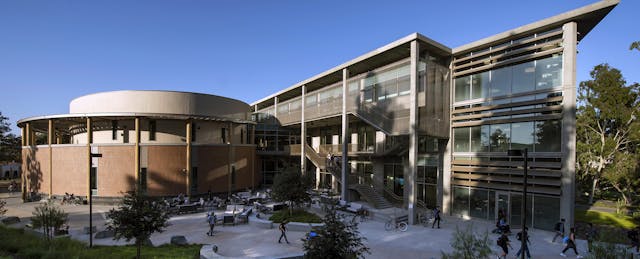When class isn’t in session, UC Irvine’s shiny new Anteater Learning Pavillion looks like any modern campus building. There are large lecture halls, hard-wired lecture capture technology, smaller classrooms, casual study spaces and brightly colored swivel chairs.
But there’s more going on in this three-level, $67-million facility, which opened its doors in September. For starters, the space is dedicated to “active learning,” a term that often refers to teaching styles that go beyond a one-way lecture format. That could range from simply giving students a chance to pause and discuss with peers, to role playing, to polling students during class, and more.
To find out what that really looks like—and more importantly, if it works—the campus is also conducting a major study over the next year to assess active learning in the new building. According to Mathew Williams, principal analyst for learning environments and technology at the university, the study will involve a mix of class observations, student and faculty surveys, interview and focus groups, and course outcomes data.
Much of the research will focus on examining different active learning strategies that faculty use, as well as its outcomes for students. In other words, Williams said in an email interview, “how are the learning environments and the instructional strategies working together, when are they most effective, and for who?”

Students are key to the active learning research. Not only as subjects, but as researchers themselves. Over the next year, a small group of paid student researchers will be trained to observe classes and record the active learning that takes place in the pavilion.
The student researchers use a tool called the Generalized Observation and Reflection Platform , a web-based research system developed at the University of California at Davis. The data-gathering is fairly simple: The system’s dashboard has a set of “buttons” named with about 20 common classroom practices, such as lecturing, group discussion or video demonstration. The student researchers click on the buttons when they see those activities happening in class.
The goal is to see how often active learning is taking place, what that looks like, and if it’s making any difference is student learning by later bringing in course outcomes data.
The research around active learning in the space will be housed under a separate effort recently launched at UCI called the Education Research Initiative, which aims to bridge the work of teaching faculty and education researchers on campus.
Actively Certified
To encourage faculty to try active learning, the school offers an active learning certification process, and those who complete it receive priority access to teaching in the new building.
The so-called Active Learning Institute consists of eight 90-minute workshops ranging from course design, to hearing how other faculty use active learning, to technology training. After completing each workshop, faculty are observed in their class before earning a certificate. (Faculty who already use active learning in their courses can skip the course and do an observation to earn a certification.)
Andrea Aebersold is the director for faculty instructional development at UCI and runs the active-learning training program. Originally, the plan was to do one cohort per year, she says, but the voluntary course quickly filled up, and a waitlist grew. Now, three training courses slated for in 2019. So far 85 faculty have been certified since the program started this fall, and Aebersold expects 200 to be certified by next year.
Throughout the program, Aebersold says, an important lesson is telling students about active learning and why faculty are using the teaching method. As she puts it: “I really emphasize that [faculty] should be transparent about what they are teaching and how they teach it so students know there is research behind this and hopefully have a better experience in class.”
Classroom Design
The Anteater Learning Pavilion is outfitted with two major lecture halls, six large classrooms, four 30-seat classrooms, three computer labs, staff offices and meeting rooms.
Classrooms feature flexible seating and swivel chairs to allow students to move around or work in groups. Private study rooms are scattered throughout the building that students can reserve, as well as casual study and lounge areas.

While the informal study spaces and even large lecture halls are relatively low-tech, other classrooms feature tables and chairs for groups of students and large monitor displays for each group. In those classes, instructors can switch the devices between presentation mode (where students see what's on the instructor’s screen), group mode (where control of displays is handed over to the students), and a student sharing-out mode (so any student's display can be shared with the entire class).
“Active learning is an umbrella term for a broad range of different strategies intended to get students more engaged in the classroom,” says Williams. “That engagement is something you can see visibly through behaviors, but the end goal here is that visible engagement translates to cognitive engagement.”
Update: The story has been updated to more accurately describe the classroom technology.


